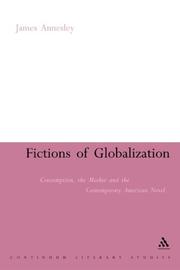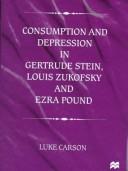| Listing 1 - 10 of 39 | << page >> |
Sort by
|
Book
ISBN: 1443848131 9781443848138 9781443897969 1443897965 Year: 2016 Publisher: [Place of publication not identified]
Abstract | Keywords | Export | Availability | Bookmark
 Loading...
Loading...Choose an application
- Reference Manager
- EndNote
- RefWorks (Direct export to RefWorks)
While modernity aspired to "fix" radical alienation through aesthetics by assigning an ethical value to narratives, contemporary literature and the arts are no longer immune to the impact of commodity culture amplified by globalization. In the world of commodity, corporate logic, and cyborgs, the very notion of identity is frequently turned into a spectacle. Yet, it is also simultaneously mobilized by the search for what Jean Baudrillard describes as the "ecstatic" form that materializes aesthetics. Ecstatic Consumption: The Spectacle of Global Dystopia in Contemporary American Literature investigates not only how these transformations affect gender, racial, and class relations, but also how they impact the representation of historical events.
Book
Year: 2007 Publisher: Ann Arbor University of Michigan Press
Abstract | Keywords | Export | Availability | Bookmark
 Loading...
Loading...Choose an application
- Reference Manager
- EndNote
- RefWorks (Direct export to RefWorks)
Book
ISBN: 9781399505734 9781399505710 1399505742 1399505734 Year: 2023 Publisher: Edinburgh Edinburgh University Press
Abstract | Keywords | Export | Availability | Bookmark
 Loading...
Loading...Choose an application
- Reference Manager
- EndNote
- RefWorks (Direct export to RefWorks)
What is a reference to an Italian Egyptologist doing in Louisa May Alcott's portrait of domesticity in Little Women? Why does Elizabeth Stuart Phelps's painter protagonist Avis Dobell know - and care - that her red shawl is dyed with desiccated beetles? Why might W. E. B. Du Bois's fictional sharecropper display a reproduction of a painting by William-Adolphe Bouguereau near his cotton field? These questions, and more, are answered by Consuming Empire in US Fiction, 1865-1930. An interdisciplinary study of references to internationally-traded commodities in US fiction, this book assembles an integrated geopolitical analysis of Americans' material, gendered, and aesthetic experiences of empire at the turn of the twentieth century. Examining allusions to contested goods like cochineal, cotton, oranges, fur, gold, pearls, porcelain, and wheat, it reveals a linked global imagination among authors who were often directly or indirectly critical of US imperial ambitions. Furthermore, the book considers the commodification of art itself, interpreting writers' allusions to paintings, sculptures, and artists as self-aware acknowledgments of their own complicity in global capitalism. As Consuming Empire in US Fiction, 1865-1930 demonstrates, literary texts have long trained consumers to imagine their relationship to the world through the things they own.

ISBN: 0826489370 Year: 2006 Publisher: London ; New York : Continuum,
Abstract | Keywords | Export | Availability | Bookmark
 Loading...
Loading...Choose an application
- Reference Manager
- EndNote
- RefWorks (Direct export to RefWorks)
Book
ISBN: 9787542631237 Year: 2009 Publisher: 上海 上海三联书店
Abstract | Keywords | Export | Availability | Bookmark
 Loading...
Loading...Choose an application
- Reference Manager
- EndNote
- RefWorks (Direct export to RefWorks)
Chinese literature --- Consumer behavior --- Consumption (Economics) in literature --- History and criticism --- History

ISBN: 0333714512 0312216629 Year: 1999 Publisher: New York, NY : MacMillan, St Martin's Press,
Abstract | Keywords | Export | Availability | Bookmark
 Loading...
Loading...Choose an application
- Reference Manager
- EndNote
- RefWorks (Direct export to RefWorks)
American literature --- Consumption (Economics) in literature. --- Depressions in literature. --- Modernism (Literature) --- History and criticism. --- History and criticism --- CONSUMPTION (ECONOMICS) IN LITERATURE --- AMERICAN LITERATURE --- ZUKOFSKY (LOUIS) --- POUND (EZRA LOOMIS), 1885-1972 --- STEIN (GERTRUDE), 1874-1946 --- 20th CENTURY --- HISTORY AND CRITICISM
Book
ISBN: 0804792992 9780804792998 9780804791960 0804791961 Year: 2014 Publisher: Stanford, California
Abstract | Keywords | Export | Availability | Bookmark
 Loading...
Loading...Choose an application
- Reference Manager
- EndNote
- RefWorks (Direct export to RefWorks)
This title examines the oppositional emergence and eventual ideological containment of 'rugged consumers' in late 20th century American literature, who creatively misuse, reuse, and repurpose the objects within their environments to suit their idiosyncratic needs and desires. The book shows how certain authors position their rugged consumers within the intertwined American myths of primal nature and rugged individualism, creating left- and right-libertarian maker communities that are skeptical of both traditional political institutions and (in its pre-neoliberal state) globalised corporate capitalism.
Book
ISBN: 9782355770340 Year: 2012 Publisher: Sainte-Colombe-sur-Gand (Loire) : la Rumeur libre éditions,
Abstract | Keywords | Export | Availability | Bookmark
 Loading...
Loading...Choose an application
- Reference Manager
- EndNote
- RefWorks (Direct export to RefWorks)
A travers sa vision de la société consumériste et d'un modèle capitaliste asservissant la liberté humaine, l'auteur dénonce avec noirceur les barbaries et les folies d'un monde en mutation.
Book
ISBN: 1282458701 9786612458705 1400832128 9781400832125 0691139849 9780691139845 Year: 2009 Publisher: Princeton, NJ
Abstract | Keywords | Export | Availability | Bookmark
 Loading...
Loading...Choose an application
- Reference Manager
- EndNote
- RefWorks (Direct export to RefWorks)
Why was eighteenth-century English culture so fascinated with the things its society discarded? Why did Restoration and Augustan writers such as Milton, Dryden, Swift, and Pope describe, catalog, and memorialize the waste matter that their social and political worlds wanted to get rid of--from the theological dregs in Paradise Lost to the excrements in "The Lady's Dressing Room" and the corpses of A Journal of the Plague Year? In Making Waste, the first book about refuse and its place in Enlightenment literature and culture, Sophie Gee examines the meaning of waste at the moment when the early modern world was turning modern. Gee explains how English writers used contemporary theological and philosophical texts about unwanted and leftover matter to explore secular, literary relationships between waste and value. She finds that, in the eighteenth century, waste was as culturally valuable as it was practically worthless--and that waste paradoxically revealed the things that the culture cherished most. The surprising central insight of Making Waste is that the creation of value always generates waste. Waste is therefore a sign--though a perverse one--that value and meaning have been made. Even when it appears to symbolize civic, economic, and political failure, waste is in fact restorative, a sign of cultural invigoration and imaginative abundance. Challenging the conventional association of Enlightenment culture with political and social improvement, and scientific and commercial progress, Making Waste has important insights for cultural and intellectual history as well as literary studies.
Book
ISBN: 9781137405661 113740566X Year: 2015 Publisher: New York: Palgrave MacMillan,
Abstract | Keywords | Export | Availability | Bookmark
 Loading...
Loading...Choose an application
- Reference Manager
- EndNote
- RefWorks (Direct export to RefWorks)
"Establishing the field of Waste Studies, a material ecocritical approach, The Literature of Waste traces literal and figurative waste in the western canon. The materiality of waste - as in landfills, trashcans, garbage dumps, compost piles - inevitably transforms into metaphor. Waste emerges out of various disciplines, such as anthropological codification, psychological repression of bodily decay, sociological civilizing process, historical garbaging of the past, economic conspicuous consumption, urban disposal of bodily waste, religious sin, and philosophical angst. Vibrant materialism disturbs the use of the metaphor of waste used to characterize people as disposable garbage. If we can read waste as possessing dynamic agency, how might that change the ethics of refuse-ing and ostracizing wasted humans? Poets, the ragpickers of litter-ature, cure homeopathically. Waste, Compost, and Gleaning Aesthetics acknowledge the poignancy of materiality by revealing the humanity we share. "-- Provided by publisher
| Listing 1 - 10 of 39 | << page >> |
Sort by
|

 Search
Search Feedback
Feedback About UniCat
About UniCat  Help
Help News
News